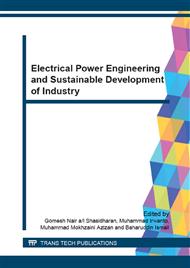p.412
p.417
p.425
p.430
p.435
p.440
p.445
p.450
p.457
Enhancement of Intrinsic Carrier Concentration in the Active Layer of Solar Cell Using Indium Nitride Quantum Dot
Abstract:
This paper presents the improvement of intrinsic carrier concentrations in the active layer of solar cell structure using Indium Nitride quantum dot as the active layer material. We have analyzed effective density of states in conduction band and valance band of the solar cell numerically using Si, Ge and InN quantum dot in the active layer of the solar cell structure in order to improve the intrinsic carrier concentration within the active layer of the solar cell. Then obtained numerical results were compared. From the comparison results it has been revealed that the application of InN quantum dot in the active layer of the device structure improves the effective density of states both in conduction band and in the valance band. Consiquently the intrinsic carrier concentration has been improved significently by using InN quantum dot in the solart cell structure.
Info:
Periodical:
Pages:
435-439
Citation:
Online since:
September 2015
Authors:
Keywords:
Price:
Сopyright:
© 2015 Trans Tech Publications Ltd. All Rights Reserved
Share:
Citation:


